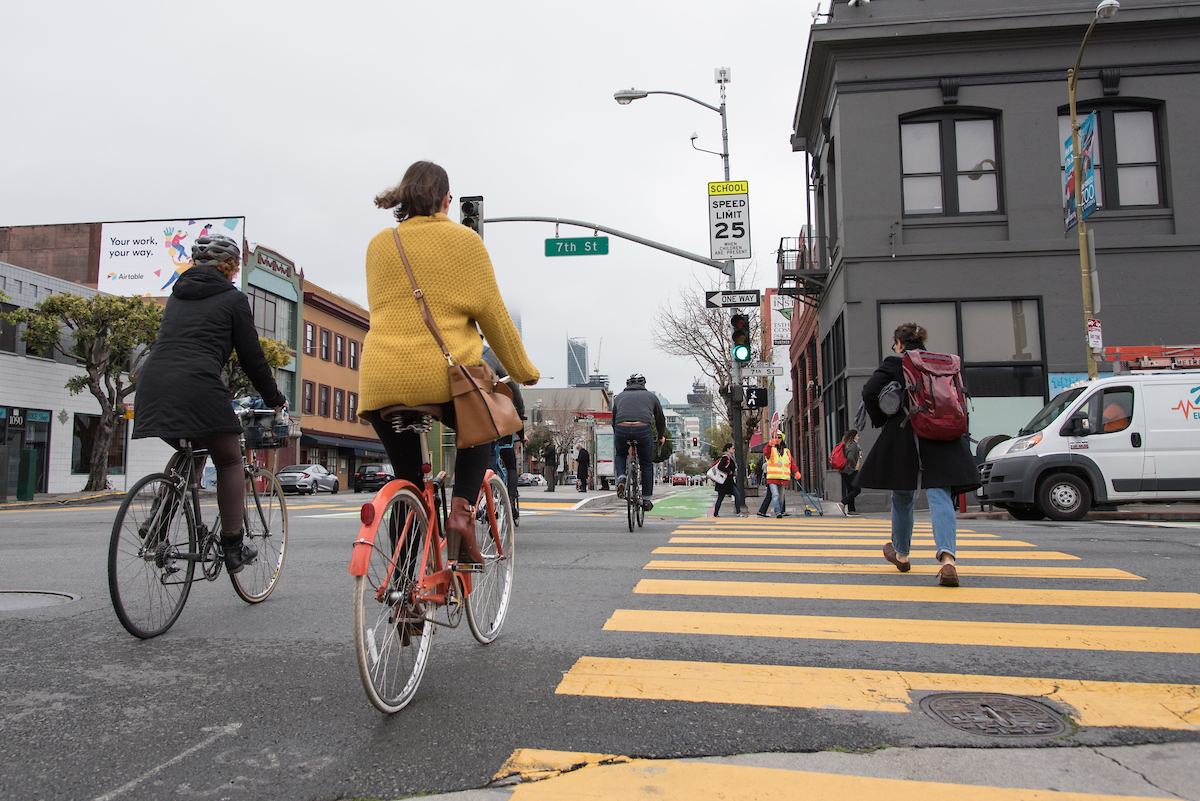By Melissa Culross
 As of Jan. 1, 2024, bicyclists in California legally can cross a street on a pedestrian walk signal, instead of waiting for a traffic light.
As of Jan. 1, 2024, bicyclists in California legally can cross a street on a pedestrian walk signal, instead of waiting for a traffic light.
Several new state laws that took effect on Jan. 1, 2024, will have an impact on transportation in San Francisco. Some of these impacts will be more widespread and immediately felt than others, but all are expected to make San Francisco streets safer.
Street Safety and Vision Zero
AB 251 (Ward) - This law requires the California Transportation Commission (CTC) to study the relationship between vehicle weight and injuries to vulnerable road users, such as pedestrians and cyclists. Vehicles have been increasing in size and weight in recent years, while pedestrian fatalities in the U.S. reached a four-decade high in 2021. The CTC will also study the possible costs and benefits of a passenger vehicle weight fee and how the funds created by such a fee might be used to improve road safety.
AB 361 (Ward) - This law authorizes local agencies to install forward-facing cameras on city-owned or district-owned vehicles to enforce bicycle lane violations. AB 361 gives the agency another tool to support the safety of bicyclists by expanding our capacity to enforce regulations against cars blocking bike lanes. The legislation allows our enforcement officers to take still photos of bike lane parking violations until Jan. 1, 2030. The SFMTA plans to take the opportunity this legislation affords us, but a technology review will be necessary before cameras can be installed.
AB 413 (Lee) - This new law prohibits the stopping, standing or parking of a vehicle within 20 feet of any crosswalk, whether it’s marked or not, and within 15 feet of a crosswalk with a curb extension. This change, known as “daylighting,” will only apply to the approach side of an intersection, and cities will have the ability to allow parking within 20 feet of a crosswalk that has clear signage or a painted curb. The legislation requires warnings to be issued until the beginning of next year, unless a violation occurs in an area marked with paint or a sign. The SFMTA has been a strong proponent of daylighting to increase pedestrian safety. Keeping the area next to crosswalks clear of parked vehicles allows pedestrians, drivers, bicyclists and anyone else rolling down the street to see each other more clearly. We are reviewing AB 413 and how it will be implemented in San Francisco, including how we can work with safety advocates, other cities and the DMV to increase awareness about the law.
AB 645 (Friedman) - This law gives San Francisco, Los Angeles, Oakland, San Jose, Long Beach and Glendale the authority to implement a five-year speed safety camera pilot program. The speed cameras will be used on San Francisco’s High Injury Network, the 12% of streets where more than 68% of severe and fatal traffic crashes occur, and possibly at other locations where speeding is a known issue. Unsafe speed is the number one factor in fatal traffic crashes in San Francisco. We are working to identify potential locations for the speed cameras and developing a plan for outreach and engagement with local stakeholder organizations, including racial equity, privacy protection and economic justice groups.
AB 1909 (Friedman) – Most of this law, an omnibus bicycle bill, went into effect last year, but an important provision took effect on Jan. 1, 2024. AB 1909 amends the vehicle code to make it legal for people riding bikes to cross the street on a pedestrian walk signal, unless otherwise directed by a bicycle control signal. Previously it was only legal for bikes to cross the street on a green traffic light with automobile traffic.
Transit Safety
SB 434 (Min) - This law is intended to reduce the harassment of women and other vulnerable groups on public transit by collecting better data on these incidents. It requires the state’s ten largest transit agencies by ridership, including the SFMTA, to conduct public outreach and survey riders about their experiences with safety while waiting for or riding on transit. This legislation builds upon the SFMTA’s Safety Equity Initiative that is currently underway. Last year we launched MuniSafe, a campaign to enhance security and increase the reporting, investigation and prevention of harassment and assaults on Muni.
Published January 09, 2024 at 07:18PM
https://ift.tt/85yjXIx

0 تعليقات على " New State Laws Are Coming to the Streets of San Francisco "